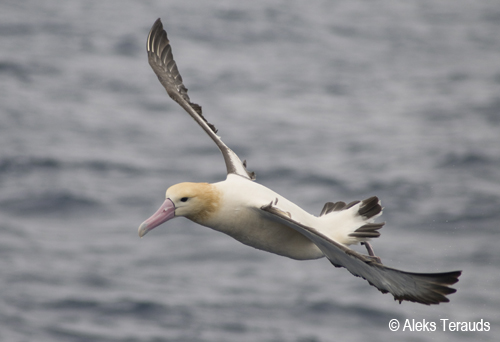The North Pacific Albatross Working Group (NPAWG) met in an open forum last week as part of the 39th Annual Meeting of the Pacific Seabird Group held on the island of Oahu, Hawaii, USA (click here to access the meeting's agenda, as well as the minutes of previous meetings).
The North Pacific Albatross Working Group was formed in 2000 in Honolulu, Hawai'i. The goal of the working group is to improve albatross conservation in the North Pacific through enhanced communication and coordination for protection, management, monitoring, outreach and research activities, both nationally and internationally. Anyone interested in albatross conservation is encouraged to join the group and to attend its meetings (click here).
The well-attended half-day 12th Annual Meeting of NPAWG was convened by its current Chair, Lindsay Young of Pacific Rim Conservation. The format of the meeting took the shape of a series of report-back presentations on matters of interest to the conservation of the three species of North Pacific albatrosses. Updates on seabird bycatch issues in Canadian, West Coast, Hawaiian and Alaskan longline fisheries enabled an understanding of progress achieved, but also of what still needed to be done to reduce seabird mortality at sea still further.
Shannon Fitzgerald (Alaska Fisheries Science Center) reported on bycatch in the Alaskan Groundfish fisheries that use demersal longline, trawl and pot vessels. Seabird bycatch between 1993 and 2010 ranged from 5000 to over 25 000 birds a year. However, the use of bird-scaring "streamer" lines in longline fisheries has reduced seabird mortality by over half (62.2%%) from 2002 when mitigation measures were adopted, with a 73.8% reduction in the mortality of albatrosses, down to 285 birds a year, mostly Laysan Albatrosses Phoebastria immutabilis. Only a very few Short-tailed Albatrosses P. albatrus have been reported taken ocer the period, with an overall estimate of mortality since the early 1990s of around 25 individuals. Among albatrosses only Laysans are reported as taken, in small numbers, by Alaskan trawlers.

Short-tailed Albatross at sea. Photograph by Aleks Terauds
Daniel Luers (Joint Institute for Marine and Atmospheric Research) spoke on seabird bycatch in Hawaiian-based deep- and shallow-set longline fisheries. Mortality of both Laysan and Black-footed P. nigripes albatrosses occurs, with the numbers of each species being reported as killed a year being generally under 100, but with marked annual fluctuations, at least partially due to variations in fishing effort.
George Wallace, Vice President, Oceans and Islands Division of the American Bird Conservancy, spoke on recent policy developments of relevance to North Pacific albatrosses, inter alia informing attendees of his understanding of the current ‘state of play' with the USA becoming a Party to the Albatross and Petrel Agreement. Although not as yet a Party, the USA regularly sends delegations to ACAP meetings and continues to support materially a number of ACAP initiatives.
With grateful thanks to the Pacific Seabird Group for sponsoring my attendance at its 2012 meeting.
John Cooper, ACAP Information Officer, 14 February 2012

 English
English  Français
Français  Español
Español